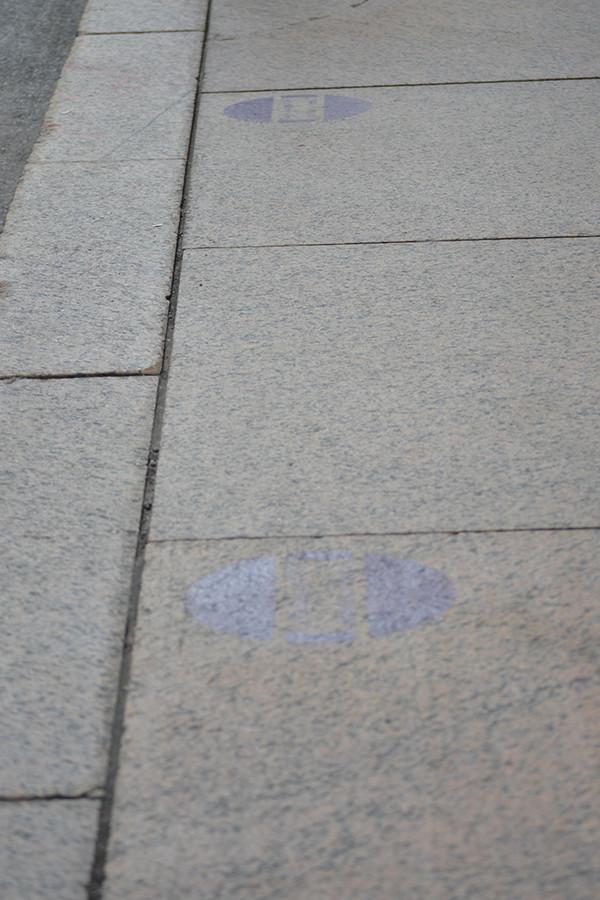Tobacco-free initiative struggles to spark among students
The new purple dot anti-smoking campaign has seen limited success amongst students.
October 6, 2015
A collection of cigarette butts sits on the sidewalk outside the entrance to Bobst Library, discarded by the clusters of students who briefly step away from their studies to smoke. While this may hardly faze returning students, the presence of smoking outside the library demonstrates the struggle of a recently launched initiative to ride certain campus building’s entrances of smokers.
After receiving complaints last year from Weinstein residents and Bobst workers who noted that the smell of cigarette smoke rose from the street into these buildings, the Inter-Residence Hall Council and the Student Senators Council joined together to address the risks posed to those who inhale secondhand smoke on campus. At the beginning of September, the SSC officially launched the Tobacco-Free initiative, painting purple dots and installing signs outside Weinstein and Bobst to delineate designated non-smoking areas.
The recent implementations outside these two buildings serve as a pilot program for the initiative and will be expanded upon after the results are analyzed.
But in its current form, the program has witnessed only limited success. Following an initial decrease in the number of cigarette butts found in the newly demarcated no smoking areas and a reduction in people visibly smoking directly outside Bobst and Weinstein, students have resumed their old habits, uninhibited by recent relocation attempts.
Amanda Ezechi, a CAS junior and the CAS Senator who helped found the initiative, acknowledged the limited efficacy.
“I think definitely in the beginning, we had students that were smoking outside of the dots,” Ezechi said. “Now I don’t think I could say that with such conviction. If you walk past Weinstein you see the cigarette butts within the dots.”
Ezechi and other student leaders attributed the low level of community response in part to the inadequate visibility of the laminated posters and fading purple dots. Some students smoking within the purple dots, like Steinhardt freshman Abby Wu, supported this analysis of the limited response to the pilot program.
“I didn’t even notice this sign,” Wu said.
CAS junior and Communications Director for the SSC Petey Shivery said the program is designed to at least make smokers aware of their actions.
“The real goal of this whole campaign is for smokers to be cognizant that you aren’t only affecting yourself, you’re mostly affecting the community, individuals who don’t want that secondhand smoke,” Shivery said.
Shivery added that the program’s efficacy is limited by students not noticing these implementations.
But Wu also pointed out that the habits of upperclassmen, acclimated to smoking in the now-prohibited area — and the transfer of these habits to new students — created difficulties for the initiative.
“We come to campus the first day, and everybody is actually gathering here to smoke,” Wu said. “Since everybody is here it gives me an impression. It looks like it is a smoking area for everybody.”
Other students, however, said the issue was not lack of awareness, but simply indifference. While many noticed the signs, LS freshman Tino Zhang said the continued presence of other smokers and lack of enforcement provided no motivation for them to relocate.
“When the guards go away, we’re just going to keep smoking,” Zhang said.
Despite the limited response, Ezechi and other leaders remain hopeful that the initiative will be implemented effectively.
“I wouldn’t say that it’s not realistic,” Ezechi said. “I would say that it’s hard.”
Contact Dan Moritz-Rabson at [email protected].
















































































































































Hua • Oct 9, 2015 at 5:31 pm
See: https://www.change.org/p/nyu-s-board-of-trustees-stop-closing-of-the-jerome-s-coles-sports-center-at-nyu
Michael J. McFadden • Oct 8, 2015 at 3:29 am
“the Inter-Residence Hall Council and the Student Senators Council joined together to address the risks posed to those who inhale secondhand smoke on campus”
Nonsense. There are no such risks from the outdoor smoking that would be encountered. I analyzed the exposures that would normally be encountered extensively in “TobakkoNacht — The Antismoking Endgame” and determined that, using the EPA Report guidelines as markers, and correcting for durations and concentrations of smoke outside doorways of campus buildings, a person would, on the average, have to go in and out of smoky doorways on campus ten times a day for literally 25 *million* years to produce a single case of lung cancer.
Seriously. That is how the numbers work out. Calling such a thing a “risk” is a bastardization of the English language: it’s simple propaganda. NYU has created the problem of outdoor clusters of smokers and littered butts by its refusal to provide reasonably comfortable and well-ventilated indoor smoking areas for its students and workers. There may not be any real excuse for littering itself, but I wonder what provision NYU has made for outdoor ashtrays since they kicked the smokers outside.
– MJM